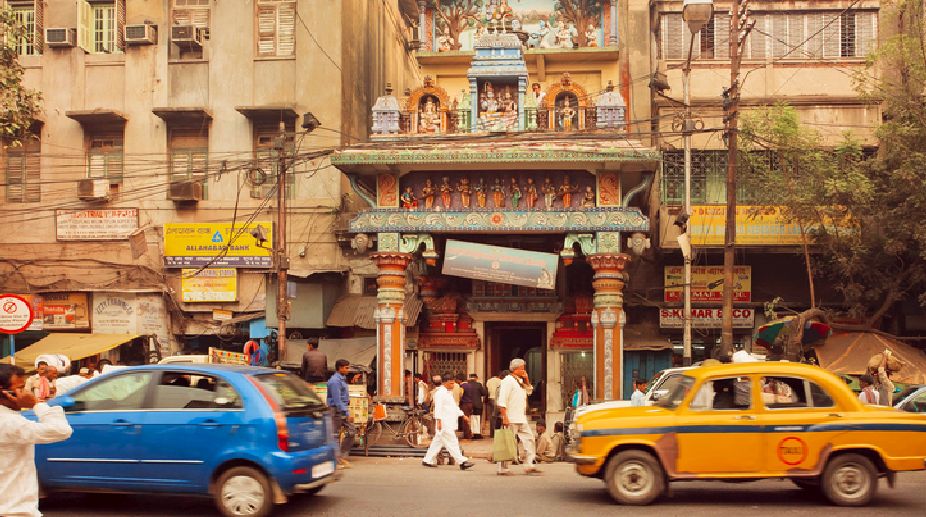City sizzles as Met dept extends heatwave alert
After sizzling at the highest day temperatures today, citizens of south Bengal, including Kolkata could face harsher days with the probability of temperature going up in the next few days.

Kolkata, West Bengal (Getty Images)
As the sun showed its face, and the shop shutters were up, the streets came into life. Babulal, the chaiwallahwas already bent over his ritual, sitting beside the radio in a basic stall. From the cauldron of bubbling tea he poured out tiny, hot cupfuls, and then carefully returned the contents of each one into a pot before decanting it back to the small terracotta cups from high aloft, to create the perfect cutting chai. His wife, Minu was busy serving tea to a group of senior citizens who were discussing something very serious.
Just one snapshot of India’s most intriguing city- Kolkata, where friendships are made instantly and strangers call us up for a chai (tea) just to pass the time and exchange ideas. It is hard to find a description that would do justice to Kolkata. Once, the capital of India this city is home to over almost 14 million people of amiable contrasts and is a buzz of intellect and creativity. It has an alluring old India charm, which can’t be experienced in any other cities.
The influence of the British Raj still runs through the veins of the town. From the grand 19th century buildings to the rambling trams, Kolkata has retained its British past.
Advertisement
The imposing colonial era structures remind us of the cultural heritage, one of the exemplary architectures being the Victoria memorial. As history says, in January 1901, after the death of Queen Victoria, George Curzon, the first Marquess Curzon of Kedleston and Viceroy of India, suggested the creation of a fitting memorial.
He proposed the construction of a grand building with a museum and gardens. King George V and the Prince of Wales laid the foundation stone on 4 January 1906, and it was legally opened to the public in 1921. Since then it has been one of the most wondrous tourist spots in Kolkata, personifying beauty and majesty. Not very far from the serenity of the Victorian grandeur, there is the St Paul’s cathedral.
Established in 1847 by Bishop Wilson, the magnificent edifice is acknowledged as the first Episcopal Church of the Eastern world. Besides being a religious site, the Cathedral is also an architectural marvel. The Cathedral’s tower is modelled on the ‘Bell Harry’ tower of Canterbury Cathedral that resembled England’s Norwich cathedral with three Gothic stained glass windows and two frescoes on Florentine Renaissance style.
A few kilometres away stand the famous Indian museum. A vast and stolid colonial edifice, it is full of unheralded oddities and treasures hidden in plain sight. From there heading towards Esplanade one will come across the well-known Chowringhee Road. Period photos have shown it as a broad European boulevard, but a snapshot taken now would tell a different story. In place of sahibs in straw hats and ladies clad in starched linen, are teeming crowds of people sheltering beneath the Grand’s covered colonnade.
That once street facing facade is now a market where refugees from Bihar and other states of the country set up shops daily and continue well after dark. Every morning they unroll bundles of tshirts, handmade gizmos, cheap wallets, plaster birds, paperbacks and set about advertising the superiority of their wares at pain level volumes.
In the vicinity of the north, there is Marble Palace, built during the 19th century by the trader Raja Rajendra Mullick to accommodate a strange hoard of Chinese urns and ornate statues of European ladies and pictures allegedly by Rubens and Murillo, whose pint now flakes and canvases droop in their frames. If one feels a bit boring down there, he can go and have a walk in its scrubby gardens, where there is the aviary and the wood caged remnants of what once must have been an impressive menagerie.
Taking a metro from Girish Park to Central would take one to College Street where there are multitudes of books of varying contents. If he/she feels hungry, the Indian coffee house is there. Built in the late 1800s as the Albert Hall, it eventually became the city’s most venerable institution of revolutionary chatter. If the contents there are not pleasing enough, there are plenty of options in Kolkata. From the signature Kosha mangsho of Golbari and the sumptuous ‘prawn cutlet’ at Mitra cafe to the delicious ‘chelo kabab’ at Peter cat and ‘biryani’ at Arsalan, Kolkata offers plethora of alternatives for lip-smacking meals. However, there is a lot more about Kolkata which can’t be penned. If one wants to know everything about Kolkata, then he will have to get under the skin of this soulful city. One cannot explore the city of joy sitting in a sealed car or rather a motor cycle. If one wants to enjoy the fervour of north Calcutta and the buzz of South, he will have to get on foot and wind through the lanes of north and the streets of South.
Advertisement